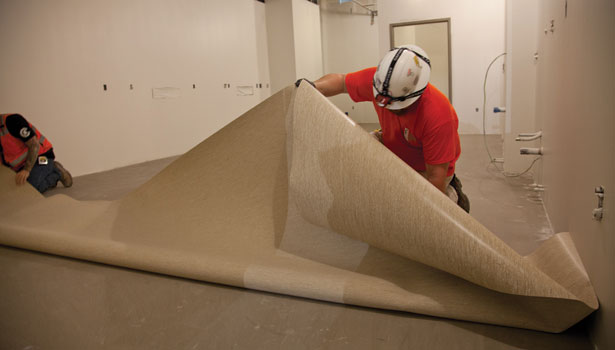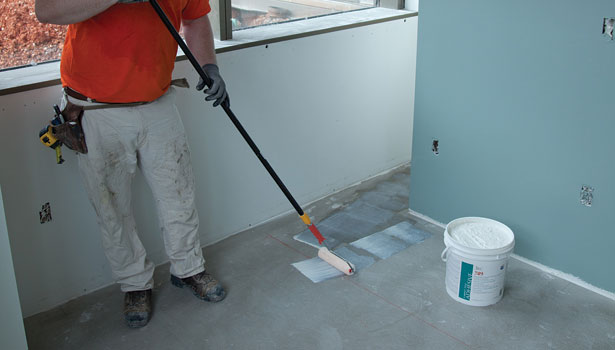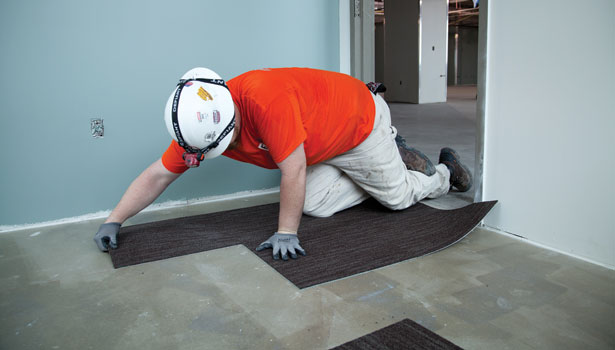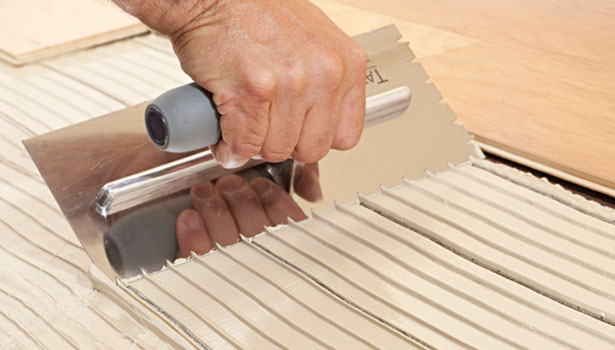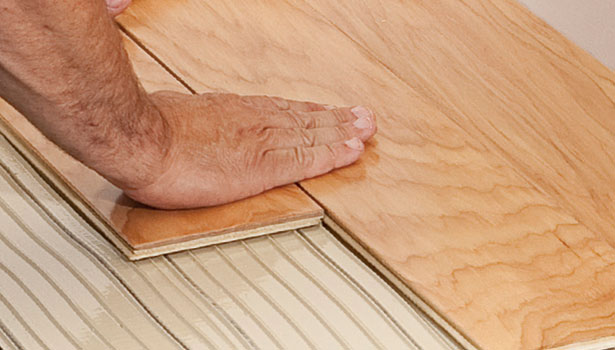No One Glue Will Do: Selecting the Right Adhesive for the Job

An installer with Flooring Systems of St. Louis lays down sheet vinyl in a new hospital using pressure sensitive glue.

To install carpet tile in a new hospital, Flooring Systems mechanics used TEC’s 749 Releasable Pressure Sensitive Adhesive.

To install carpet tile in a new hospital, Flooring Systems mechanics used TEC’s 749 Releasable Pressure Sensitive Adhesive.

The Good Samaritan Regional Health Center, a 142-bed, 500,000-square-foot hospital and Medical Plaza in Mt. Vernon, Ill., required a number of different adhesives for the successful installation of a wide variety of flooring and wall materials.

While it is important to select the correct adhesive for the job, it is equally important to use the proper trowel for spreading the glue as both work hand-in-hand in creating a professional installation.

While it is important to select the correct adhesive for the job, it is equally important to use the proper trowel for spreading the glue as both work hand-in-hand in creating a professional installation.

In addition to carpet tile and sheet vinyl, the Good Samaritan Regional Health Center called for porcelain, ceramic and quarry tile for the floors and walls, which is why numerous adhesives were required.

Tom Plaskota is the technical support manager for TEC/H.B. Fuller Construction Products and is responsible for managing the field support team that develops and communicates technical information and provides technical service. He has over 30 years of experience with construction methods, testing and materials, and has been working with the TEC brand of surface preparation and installation systems for flooring, ceramic tile and natural stone since 1997. He is actively involved with the National Tile Contractors Association and is a former Industry Director for the Chicago Chapter of the Construction Specifications Institute. Contact him at (800) 832-9023 or hbf-cp.customerservice@hbfuller.com.








The purpose of adhesives seems simple: They hold a floor covering in place.
However, they may be formulated to have additional features that contribute to the longevity of a flooring installation. Thanks to advances in technology, specialized formulations have proliferated. This explosion of products has created an opportunity for flooring retailers and installers: The chance to select an adhesive perfectly suited for a specific application. The right glue can simplify the installation process, reduce on-the job frustration and add value in terms of both aesthetics and performance.
Some adhesives are marketed as multipurpose, but the true professional knows better than to use the same product for installing carpet in a sunroom and sheet vinyl in a hospital.
For the professional contractor, the term multipurpose typically describes a product used to install carpet or mineral-backed sheet vinyl with the direct glue-down method of installation. Multipurpose adhesives are most appropriate for residential or light-traffic commercial installations.
When opting for a specialized adhesive, you should first identify the flooring material being used and the substrate to which it is being applied. Then, you should consider the installation environment, for example, its expected traffic. These factors allow you to choose the perfect product for the job.
Carpet Adhesives
Carpet tile in commercial environments has unique characteristics that affect adhesive selection. Ugly-ing out occurs when a traffic lane—a frequently traversed area—shows signs of wear after repeated foot traffic. The carpet has not worn out; it just appears crushed, matted down or flattened.
If a carpet tile will see repeated, specific traffic patterns, you should consider a releasable pressure sensitive adhesive. It will offer durable tack for aggressive bond, yet is releasable to allow for ease of replacement. With releasable adhesives, building owners can easily rotate the location of their carpet tile by removing and re-bonding, so the same tiles are not repeatedly exposed to foot traffic. In this way, releasable adhesives can increase the longevity of a carpet tile installation.
Pressure sensitive adhesives can also be used where removal and rebonding are not a concern. In some commercial environments, such as busy stores or hospitals, a temporary closure to replace or rearrange a flooring installation would be costly. Pressure-sensitive adhesives are a great option for carpet cushion and Enhancer-backed carpet tiles, as well as solid vinyl, solid rubber and solid urethane. Their ease-of-use allows for quick installation in these environments.
A strong initial grab can also contribute to an efficient carpet installation. For broadloom without an elaborate design, a strong grab allows the carpet to be rolled right away. This characteristic helps simple installations keep pace with today’s rapid installation schedules.
For more ornate carpet designs, however, turn to higher-grade adhesives formulated for using the double-bond method of installation. The product selected should have an extended open time, which allows the installer ample time to match up patterns.
These higher-end, commercial-type installations are expected to last. With that in mind, look for a premium adhesive with superior bond strength and extended open time.
Resilient Adhesives
When working with resilient flooring, make sure to consider the floor covering’s backing. Note that multipurpose adhesives can work well with felt-backed sheet vinyl, but should never be used with solid vinyl because of plasticizer migration concerns.
Your glue must be compatible with solid vinyl materials to avoid incompatible adhesive issues. Using improper glue can also cause disbonding. Be sure to check the flooring manufacturer’s recommendations for compatible adhesives.
Like carpet installations, traffic patterns—and traffic type—should influence resilient adhesive selection. If the floor will be subjected to heavy loads in localized areas, consider a harder setting adhesive like an epoxy or polyurethane. These types of loads are particularly common in patient rooms in hospitals, where the weight from beds could cause indentations in soft-setting adhesives.
Epoxies and polyurethanes also offer exceptional moisture and chemical resistance and durability, helping them contribute to successful installations in demanding environments.
Also consider environmental conditions when selecting your resilient flooring adhesives. Determine the relative humidity of your substrate, and select a glue that will withstand it. Moreover, changes in moisture can lead to expansions and contractions of a floor. Look for an adhesive with the cured strength necessary to prevent gapping.
In addition to testing moisture levels, test your substrate’s porosity with the water droplet test. Place several drops of water, about the size of a dime, on the subfloor. If the water droplets penetrate the substrate within a minute, the substrate is porous. If they remain on its surface, it is nonporous.
Make sure your adhesive is compatible with the substrate’s porosity, and consult the glue’s instructions for any installation considerations.
The installation method will also affect the adhesive choice for resilient flooring. Some floor coverings can be installed with the perimeter-bonded method. This is where the adhesive is applied only to the perimeter of the room. If this method is specified, make sure you specify an adhesive specifically designed for perimeter-adhered installations.
Wood Adhesives
Wood floors continue to grow in popularity, and glued-down wood floors tend to be more permanent than their floating counterparts. Before selecting an adhesive, be sure that your particular wood product is approved for the glue-down method of installation.
Urethane-based adhesives effectively balance the cure strength and flexibility that wood installations demand. Wood floors naturally expand and contract due to changes in moisture levels. Premium urethane formulas develop a highly elastomeric bond that moves with the normal expansion and contraction of wood flooring.
Similarly, any hardwood—including engineered—will cup or curl when exposed to moisture. For this reason, when working with engineered hardwood, you should opt for a glue that contains no water, such as a moisture cure urethane or modified silicone adhesive. These glues have no water in their make-up, which reduces the opportunity for moisture to damage the installation.
Retailers and installers should also recognize what wood adhesives are not meant to do. The most common mistakes when working with wood flooring relate to substrate preparation. Instead of filling voids or deflections in the subfloors with a cementitious patch or a self-leveling underlayment, some installers will try to compensate for substrate variation with adhesives.
However, unless the glue is specifically billed as having crack bridging capabilities, it may not be firm enough to bridge the deflection, which will cause a void as the wood pops up. Familiarize yourself with your product’s crack bridging possibilities.
Other Considerations
Environmental concerns increasingly affect all aspects of building and construction. Many contractors and architects build with an eye toward LEED certification, which includes product selection. Look for adhesives with low or no VOCs for LEED compliance. To make product selection easier, the Carpet & Rug Institute (CRI) has launched a labeling system that acknowledges environmental concerns. Its Green Label and Green Label Plus programs set high standards for indoor air quality and designate the lowest emitting products on the market.
Similarly, some installation environments have particular adhesive requirements because of air quality concerns. Make sure your glue is approved for use if working in one of these areas, which include hospitals, schools and assisted living facilities. Moreover, certain adhesives are specifically formulated to maintain healthy environments over time. These products contain micro-biocides, which can inhibit the growth of mold, mildew and bacteria.
In general, different types of adhesive chemistries offer unique, specific adhesion and performance advantages. It is critical to read the product’s label and technical data when selecting a glue, with particular focus on limitations and surface preparation.
Also take into account the flooring manufacturer’s recommendations to ensure your adhesive and floor covering work together as a system. Careful adhesive selection helps ensure that your installation meets or exceeds customer expectations.
Tom Plaskota is the technical support manager for TEC/H.B. Fuller Construction Products and is responsible for managing the field support team that develops and communicates technical information and provides technical service. He has over 30 years of experience with construction methods, testing and materials, and has been working with the TEC brand of surface preparation and installation systems for flooring, ceramic tile and natural stone since 1997. He is actively involved with the National Tile Contractors Association and is a former Industry Director for the Chicago Chapter of the Construction Specifications Institute. Contact him at (800) 832-9023 or hbf-cp.customerservice@hbfuller.com.
Looking for a reprint of this article?
From high-res PDFs to custom plaques, order your copy today!









